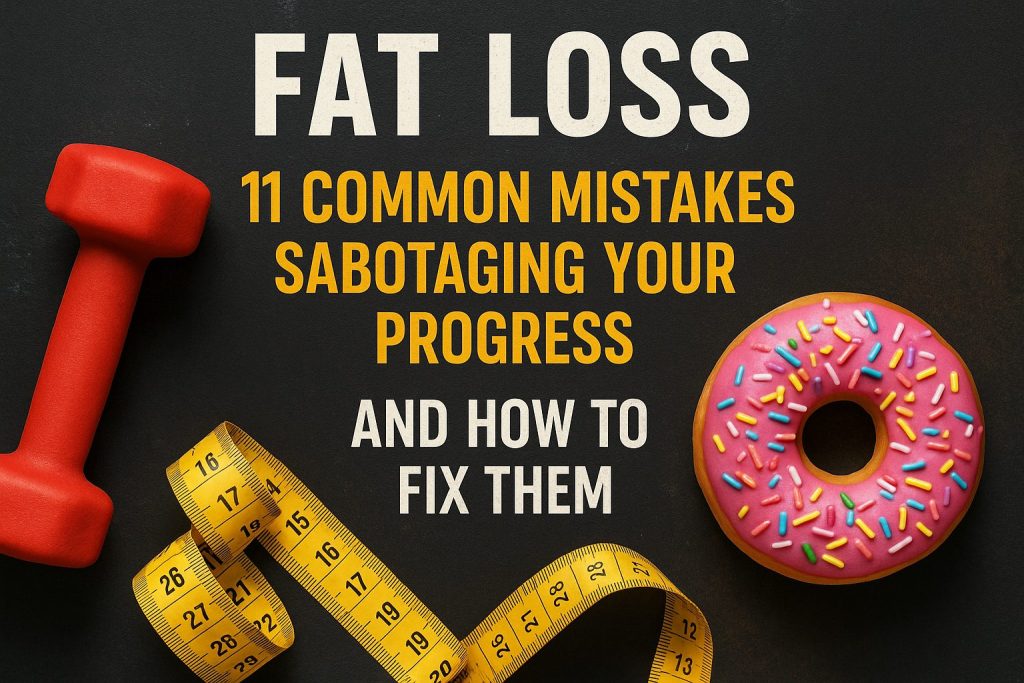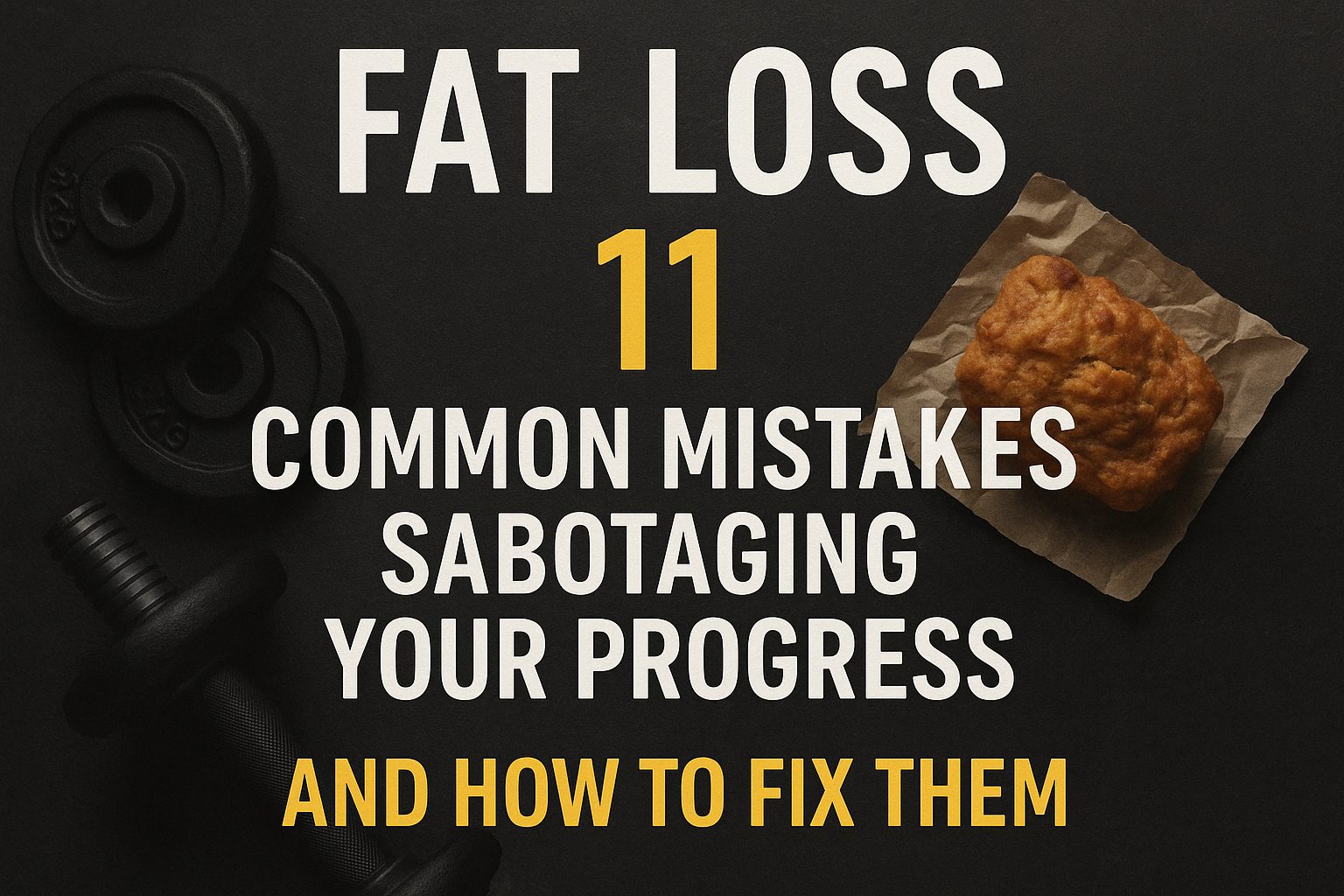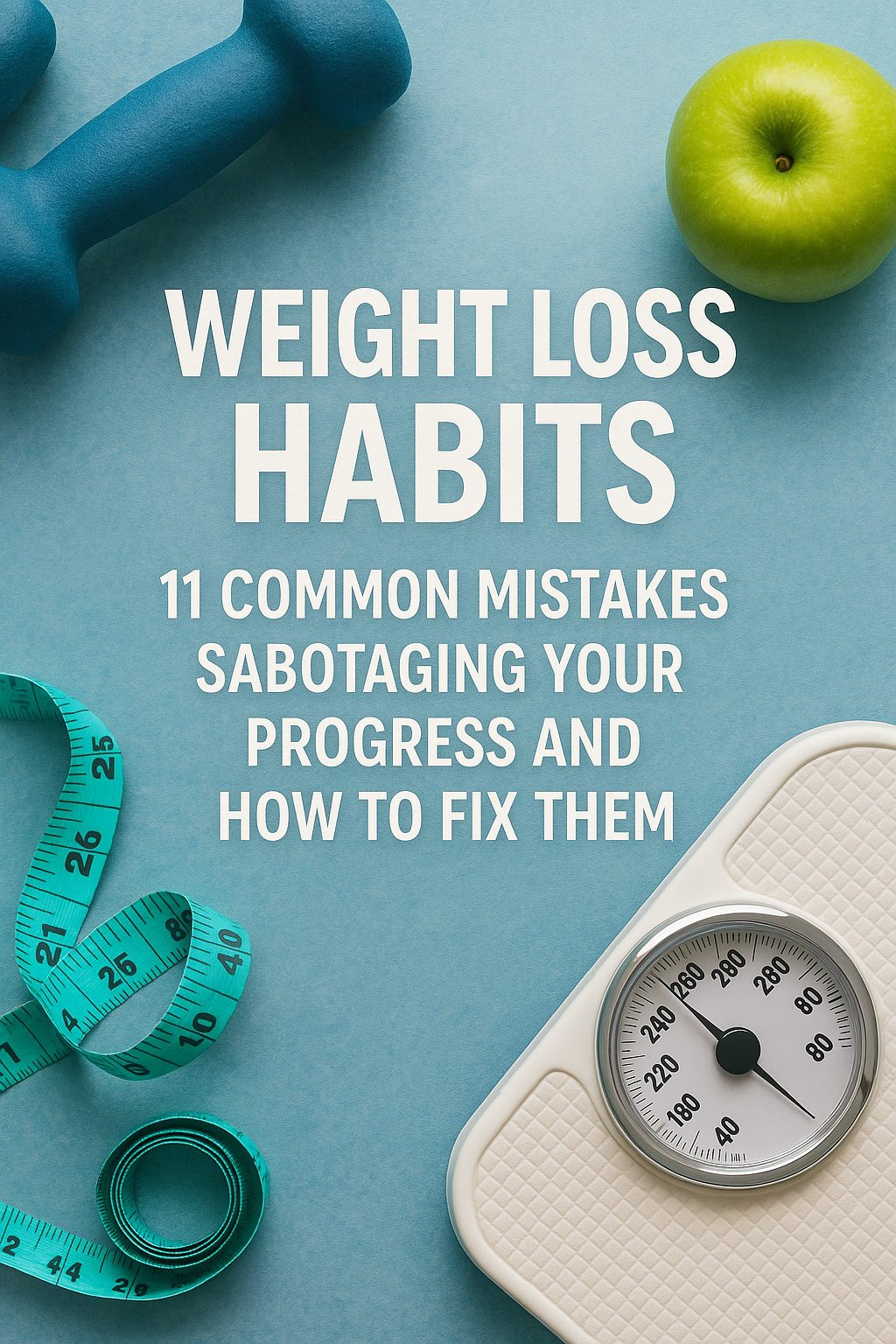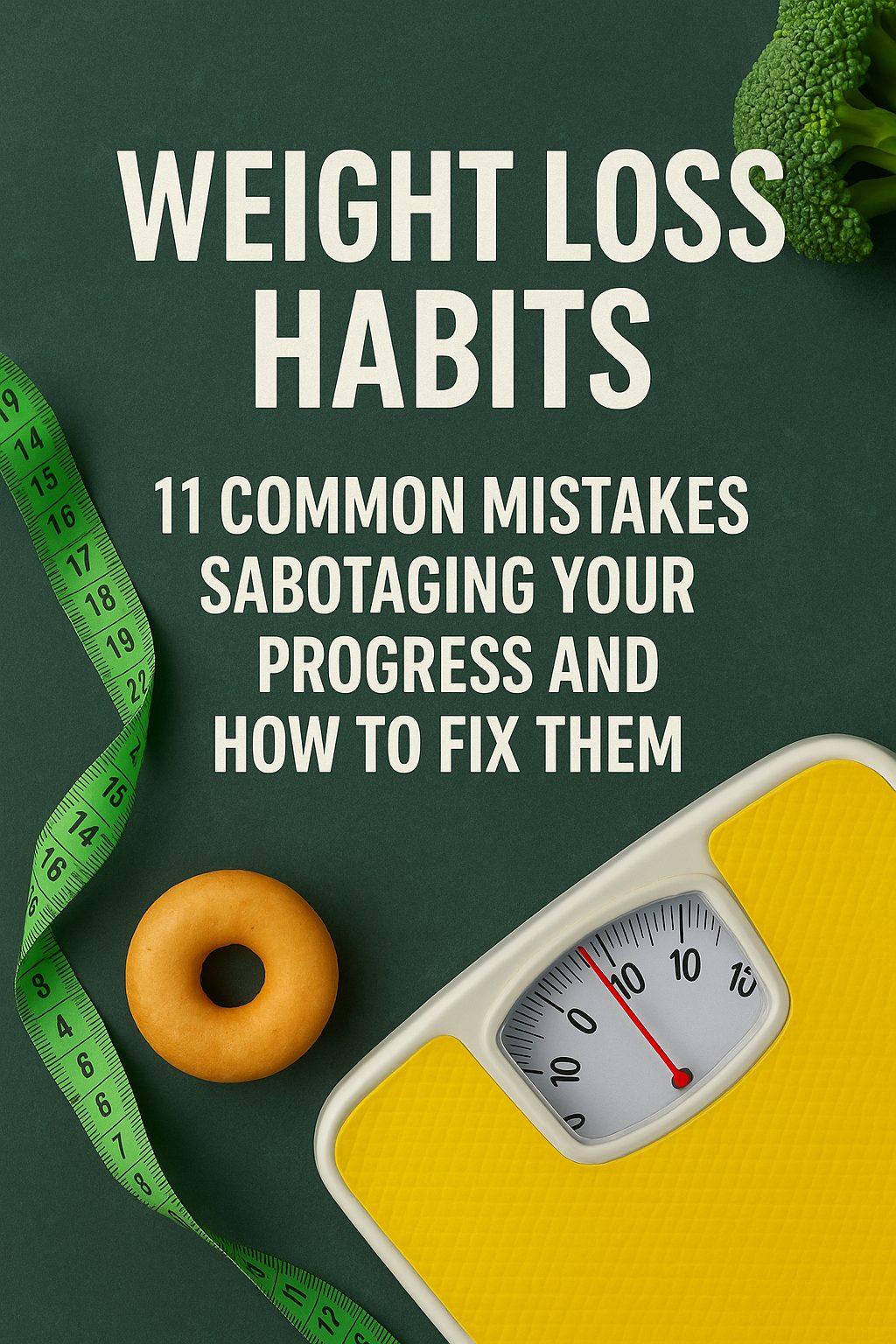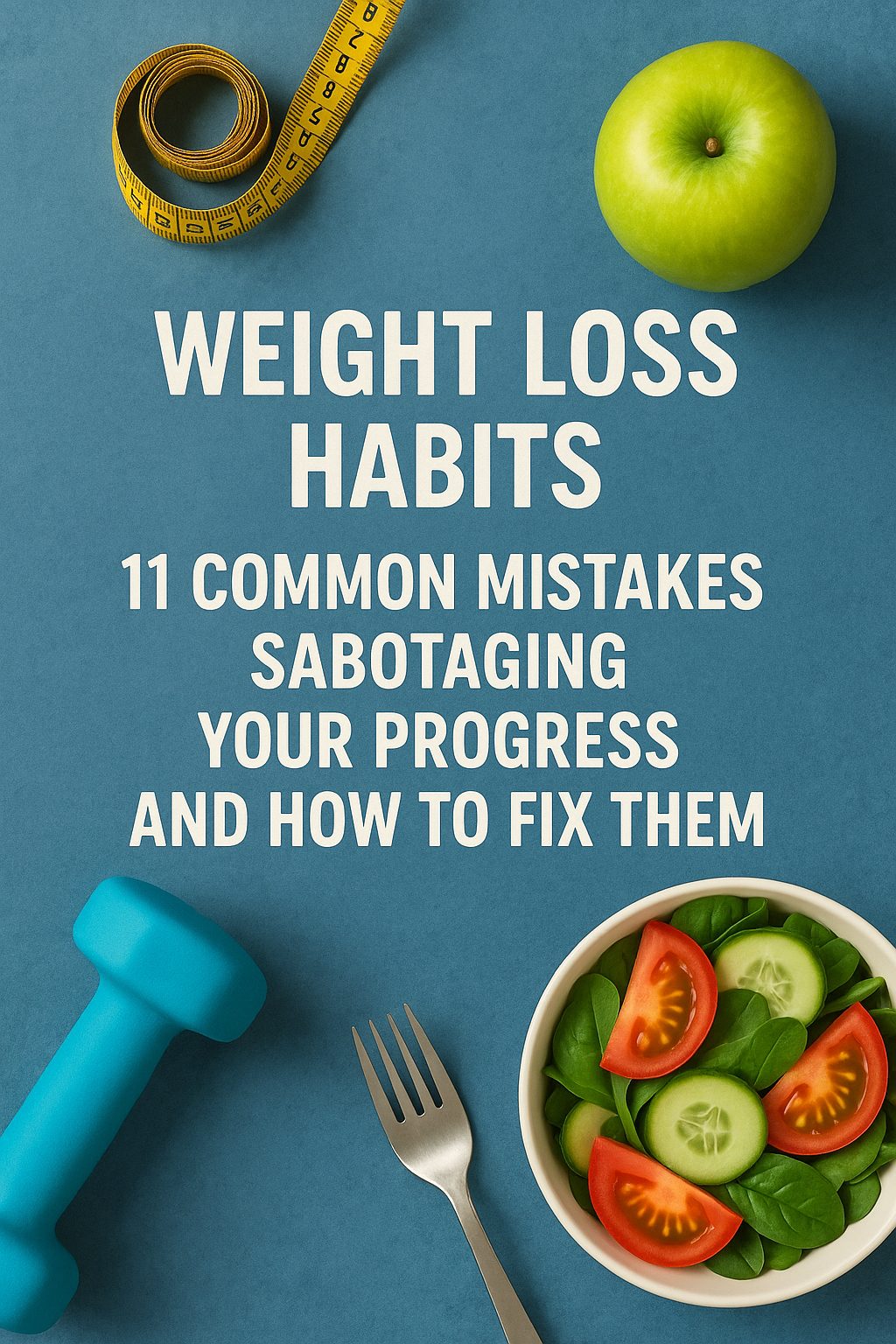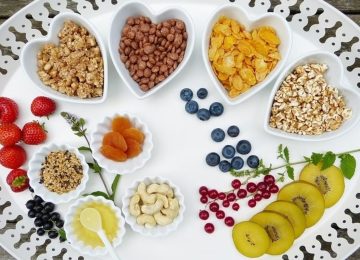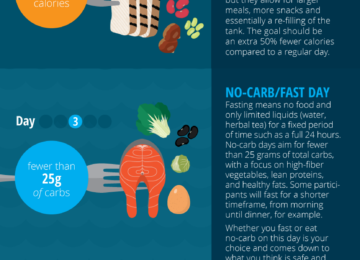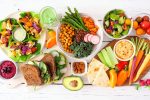Your bathroom scale hasn’t budged in weeks despite cutting calories and hitting the gym religiously. Sound familiar? You’re not alone – research shows that 95% of dieters regain lost weight within five years, often because they focus solely on what they eat rather than how their daily habits shape their relationship with food and fitness.
The difference between sustainable weight loss and another failed attempt lies in recognizing the subtle behaviors that work against your goals. These aren’t obvious mistakes like eating entire pizzas or skipping workouts for months. Instead, they’re seemingly innocent habits that slowly chip away at your progress, creating invisible barriers that keep you stuck in frustrating plateaus.

Key habits that secretly sabotage weight loss:
- Mindless eating patterns that bypass hunger signals
- Timing mistakes that disrupt your metabolism
- Hidden calorie sources you don’t even count
- All-or-nothing thinking that leads to diet cycles
- Sleep and stress factors that trigger weight gain
Understanding these patterns is crucial because lasting weight loss isn’t about perfection – it’s about identifying which specific habits are holding you back and systematically replacing them with behaviors that support your goals. Let’s explore why your daily habits matter more than any single meal or workout.
Why your weight loss habits matter more than you think
Your brain operates on autopilot for approximately 40% of your daily actions, meaning nearly half of what you do each day happens without conscious thought. This explains why you can drive home from work while thinking about dinner, or why you automatically reach for snacks while watching TV. When it comes to weight loss, this autopilot mode can either be your greatest ally or your biggest obstacle.

The habit loop that controls your weight:
- Cue – Environmental trigger (stress, boredom, specific times)
- Routine – Automatic behavior (reaching for food, skipping meals)
- Reward – Immediate satisfaction (comfort, energy, social connection)
- Repetition – Strengthens neural pathways until behavior becomes unconscious
Small habits compound over time through what researchers call the “aggregation of marginal gains.” A 100-calorie daily surplus from mindless snacking equals 10 pounds of weight gain per year. Conversely, eliminating just one bad habit while adding one supportive behavior can create a 20-pound swing in the opposite direction.
The 80/20 principle applies directly to weight management: 80% of your results come from 20% of your habits. This means identifying and changing your most impactful behaviors will drive the majority of your progress. Most people fail because they try to overhaul everything at once instead of targeting the specific habits that offer the highest return on investment.
Why willpower isn’t enough:
Your prefrontal cortex – the brain region responsible for decision-making – has limited capacity and becomes depleted throughout the day. This is why you can resist temptation all morning but find yourself elbow-deep in a bag of chips by evening. Successful weight loss requires designing your environment and routines to support good choices when willpower is low.
Habits also create identity shifts that reinforce themselves. When you consistently choose the stairs over the elevator, you begin to see yourself as someone who prioritizes movement. This identity change makes future healthy choices feel natural rather than forced, creating sustainable momentum that doesn’t rely on constant motivation.
The 11 weight loss habits that are sabotaging your progress
Skipping breakfast regularly

Your morning meal sets the metabolic tone for your entire day, yet 25% of adults regularly skip breakfast thinking it will help them lose weight faster. This backfires in multiple ways that compound throughout the day, creating a cascade of poor choices that ultimately lead to weight gain rather than loss.
When you skip breakfast, your body interprets this as a famine signal and responds by slowing your metabolism to conserve energy. Your cortisol levels remain elevated longer, promoting fat storage particularly around your midsection. Additionally, your blood sugar drops significantly by mid-morning, triggering intense cravings for high-calorie, processed foods that provide quick energy.
The afternoon overeating cycle:
Research from the American Journal of Clinical Nutrition shows that breakfast skippers consume an average of 400 more calories at lunch and dinner combined. This happens because:
- Ghrelin spikes – Your hunger hormone reaches peak levels by noon
- Decision fatigue sets in – Your depleted willpower makes poor food choices easier
- Blood sugar crashes – Leading to cravings for sugary, high-fat foods
- Portion distortion occurs – Extreme hunger makes normal portions feel inadequate
The quality of your breakfast matters as much as eating it consistently. Meals high in protein (20-30 grams) and fiber keep you satisfied longer while supporting muscle preservation during weight loss. This combination also helps regulate your appetite hormones throughout the day.
Solution: The 5-minute breakfast formula
Create a rotation of quick, protein-rich breakfasts you can prepare in 5 minutes or less:
- Greek yogurt parfait – Plain Greek yogurt + berries + nuts (25g protein)
- Protein smoothie – Protein powder + spinach + banana + almond milk (30g protein)
- Egg scramble – 2 eggs + vegetables + cheese + toast (20g protein)
- Overnight oats – Oats + protein powder + chia seeds + fruit (22g protein)
Prepare ingredients the night before to eliminate morning decision-making. Keep backup options like protein bars or hard-boiled eggs readily available for chaotic mornings when cooking isn’t possible.
Mindless snacking while distracted

Your hand reaches into the chip bag while scrolling through social media, and suddenly half the bag is gone without you even noticing. This scenario plays out millions of times daily, making distracted eating one of the most common weight loss saboteurs in our hyperconnected world.
When your attention is divided between food and screens, your brain fails to register satiety signals properly. The vagus nerve, which communicates fullness from your stomach to your brain, becomes less responsive during distracted eating. Studies show that people consume up to 50% more calories when eating while watching TV, using phones, or working at computers.
The neuroscience behind mindless eating:
Your brain requires conscious attention to process taste, texture, and satisfaction from food. When distracted, you miss these crucial sensory inputs that normally trigger feelings of fullness. This creates a disconnect where you can consume large quantities without experiencing psychological satisfaction, leaving you feeling unsatisfied despite overeating.
Stress compounds this problem significantly. Elevated cortisol levels increase cravings for high-calorie comfort foods while simultaneously impairing your ability to recognize when you’ve had enough. The combination of stress hormones and divided attention creates the perfect storm for unconscious overconsumption.
Common distracted eating triggers:
- Screen time – TV, phones, tablets, computers during meals
- Emotional states – Boredom, anxiety, frustration, loneliness
- Environmental cues – Open packages, visible food, social situations
- Multitasking – Working, driving, reading while eating
- Habitual patterns – Specific locations or times that trigger automatic eating
| Distraction Type | Average Calorie Increase | Common Foods Consumed |
|---|---|---|
| TV watching | 25-30% | Chips, candy, ice cream |
| Phone scrolling | 35-40% | Nuts, crackers, popcorn |
| Work/studying | 20-25% | Granola bars, cookies |
| Emotional eating | 45-60% | Chocolate, pastries, comfort foods |
Solution: The mindful eating reset
Transform distracted eating into conscious consumption with these practical strategies:
1. Create eating zones Designate specific areas for food consumption only. Never eat while standing at the kitchen counter, sitting at your desk, or lying in bed. This physical boundary helps your brain associate these spaces with focused eating.
2. Use the 20-minute rule It takes approximately 20 minutes for your brain to register fullness signals from your stomach. Slow down your eating pace by:
- Putting your fork down between bites
- Chewing each bite 15-20 times
- Taking sips of water throughout the meal
- Engaging in conversation if eating with others
3. Implement the pause protocol Before reaching for any snack, stop and ask yourself three questions:
- Am I physically hungry or just bored/stressed?
- What am I really craving right now?
- Will this food help me reach my goals?
This 30-second pause activates your prefrontal cortex and breaks the automatic reaching pattern.
4. Practice portion pre-commitment Never eat directly from packages or containers. Always portion out your intended serving size before eating begins. This visual cue helps prevent the “portion creep” that happens during distracted consumption.
Drinking your calories without realizing it

Liquid calories represent one of the most overlooked sources of weight gain because beverages don’t trigger the same satiety responses as solid foods. Your brain doesn’t compensate for liquid calories by reducing food intake later, meaning these “bonus” calories get added directly to your daily total without affecting hunger.
The average American consumes 400-500 calories daily from beverages alone – equivalent to 40-50 pounds of potential weight gain per year. Even seemingly healthy drinks can pack surprising caloric punches that derail weight loss efforts.
Hidden calorie bombs in common beverages:
Coffee shop drinks often contain more calories than entire meals. A large flavored latte can pack 500+ calories, while specialty smoothies frequently exceed 800 calories due to added sugars, syrups, and high-calorie mix-ins like granola or honey.
Alcohol presents a double challenge: it contains 7 calories per gram (nearly as much as fat) while simultaneously lowering inhibitions around food choices. Additionally, your body prioritizes metabolizing alcohol over burning stored fat, effectively putting weight loss on pause whenever alcohol is in your system.
The insulin response problem:
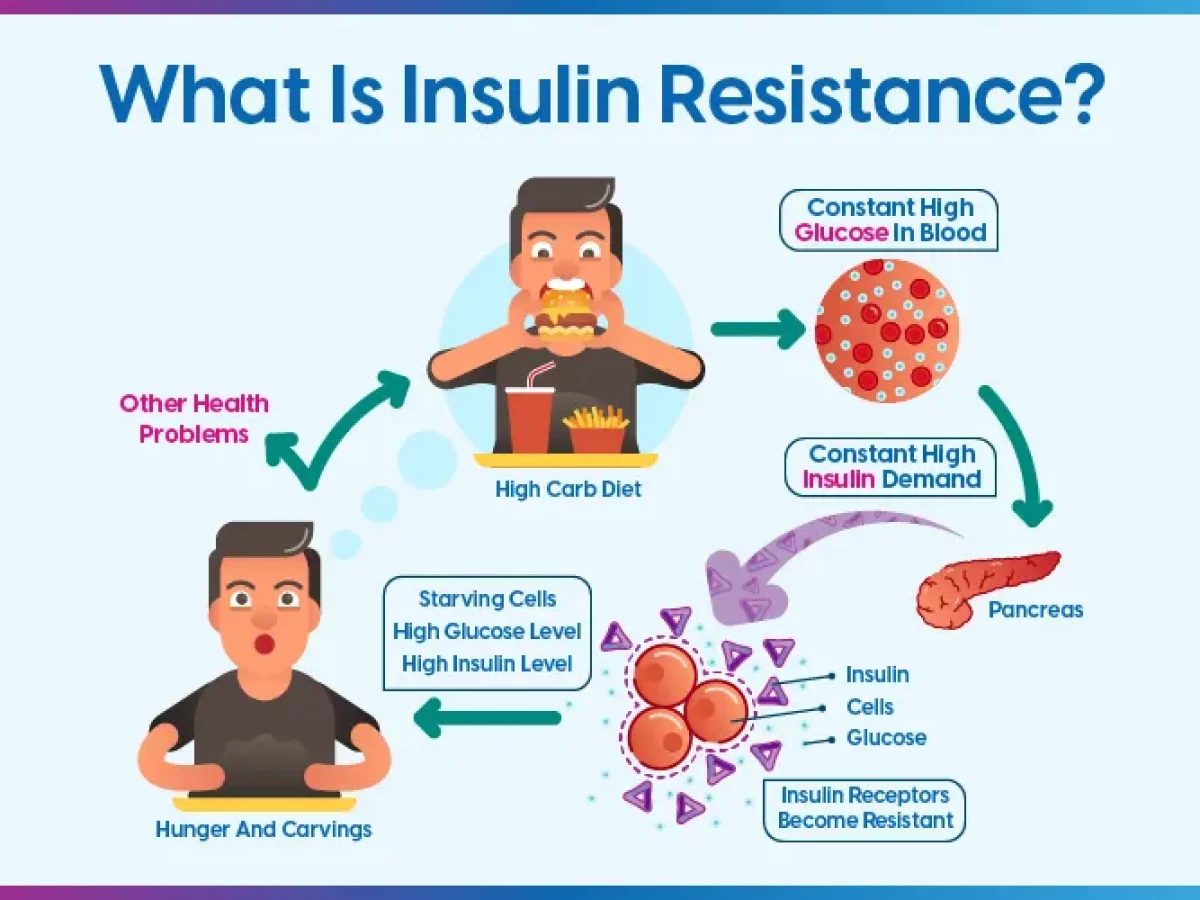
Sugary beverages cause rapid blood sugar spikes followed by crashes that trigger hunger and cravings within 1-2 hours of consumption. This creates a cycle where liquid calories not only add to your daily total but also increase your appetite for additional food throughout the day.
Diet sodas, while calorie-free, can still interfere with weight loss by altering gut bacteria and potentially increasing sweet cravings. Some studies suggest artificial sweeteners may disrupt glucose metabolism, though the research remains mixed.
Solution: Strategic beverage swaps
Replace high-calorie drinks with satisfying alternatives that support your weight loss goals:
Morning energizers:
- Black coffee or tea with cinnamon instead of flavored lattes
- Green tea with lemon for metabolism boost
- Herbal teas for variety without calories
Afternoon refreshers:
- Sparkling water with fresh fruit instead of sodas
- Unsweetened iced tea with mint
- Cucumber or lemon-infused water
Evening options:
- Herbal teas for relaxation
- Bone broth for protein and warmth
- Decaf coffee with unsweetened almond milk
Alcohol strategies: When you choose to drink, optimize your selections:
- Wine or spirits with soda water instead of mixed drinks
- Alternate alcoholic beverages with full glasses of water
- Eat protein-rich foods before drinking to slow absorption
- Set a 2-drink maximum and stick to it
Track your beverage intake for one week using your phone’s notes app. Most people are shocked to discover they’re drinking 300-600 calories daily without realizing it. This awareness alone often leads to immediate improvements in drink choices.
All-or-nothing mentality with diet

Perfect adherence to any diet plan is impossible, yet many dieters abandon their entire weight loss effort after a single “slip-up.” This black-and-white thinking creates a destructive cycle where minor deviations trigger complete dietary abandonment, often leading to binge eating episodes that undo weeks of progress in a single day.
The all-or-nothing mentality stems from diet culture’s emphasis on restriction and rules rather than sustainable lifestyle changes. When you label foods as “good” or “bad,” eating something “forbidden” triggers shame and the false belief that you’ve already “ruined” your diet, so you might as well eat everything in sight.
The perfectionism trap:
Research shows that dieters with perfectionist tendencies are 6 times more likely to regain lost weight within two years. This happens because perfectionism creates an unsustainable standard that inevitably leads to perceived “failure,” followed by complete abandonment of healthy habits.
Your brain interprets dietary restriction as a threat to survival. When you break strict food rules, your primitive brain assumes the famine is over and triggers compensatory overeating to restore energy reserves. This biological response explains why “cheat days” often turn into multi-day binges that derail months of progress.
Common all-or-nothing thoughts:
- “I ate a cookie, so I might as well eat the whole package”
- “I missed my workout, so this week is ruined”
- “I’ll start fresh on Monday” (while overeating through the weekend)
- “I can’t eat carbs/sugar/fat ever again”
- “If I’m not perfect, I’m failing”
The restriction-binge cycle typically follows this pattern: extreme restriction → intense cravings → “slip-up” → shame and guilt → “screw it” mentality → overeating → more guilt → renewed restriction. Breaking this cycle requires abandoning the perfectionist mindset and embracing flexibility.
Solution: The 80/20 flexible approach
Replace rigid rules with flexible guidelines that accommodate real life while maintaining progress toward your goals:
1. Adopt the 80/20 principle Aim to make nutritious choices 80% of the time while allowing 20% flexibility for social situations, cravings, and spontaneous moments. This built-in flexibility prevents the feeling of deprivation that leads to binges.
2. Practice the “next bite” reset Instead of writing off entire days or weeks, reset your intentions with the very next food choice. Had pizza for lunch? Make your afternoon snack a piece of fruit. This prevents small deviations from becoming large setbacks.
3. Create “flexible boundaries” Replace absolute rules with flexible guidelines:
- Instead of “I can never eat dessert” → “I enjoy dessert 2-3 times per week”
- Instead of “No carbs ever” → “I include whole grains in 1-2 meals daily”
- Instead of “Perfect workouts or nothing” → “I move my body in some way every day”
| Rigid Thinking | Flexible Alternative | Real-World Application |
|---|---|---|
| “No sugar ever” | “I limit added sugars” | Choose fruit over candy most days |
| “Must exercise 1 hour daily” | “I aim for 30+ minutes of movement” | Walk, dance, or do yoga when gym isn’t possible |
| “Can’t eat after 7 PM” | “I stop eating 2-3 hours before bed” | Adjust timing based on your schedule |
| “No eating out” | “I make mindful choices at restaurants” | Check menus ahead, ask for modifications |
4. Plan for imperfection Anticipate challenges and create specific strategies for common scenarios:
- Keep healthy snacks available for busy days
- Research restaurant options before social events
- Practice portion control techniques for parties
- Develop non-food stress management strategies
Ignoring portion sizes completely
Portion sizes have increased dramatically over the past 30 years, with restaurant servings now 2-5 times larger than standard recommendations. This “portion inflation” has skewed our perception of normal serving sizes, leading many people to consistently overeat even healthy foods without realizing it.
Your brain relies on visual cues to determine appropriate portion sizes, but these cues become distorted when exposed to consistently large servings. A phenomenon called “portion size effect” shows that people eat more when presented with larger portions, regardless of hunger levels or food preferences.
The psychology of portion distortion:
Large plates, bowls, and containers create an optical illusion that makes reasonable portions appear inadequate. Studies demonstrate that people consume 22% more food when eating from 12-inch plates compared to 10-inch plates, simply because the same amount of food looks smaller on the larger surface.
Package sizes also influence consumption patterns. Family-size packages of snacks lead to 25-30% higher intake per eating occasion compared to individual portions, even when people are aware they’re eating more. This happens because your brain uses the package as a portion reference point rather than relying on internal hunger cues.
Hidden calorie multiplication:
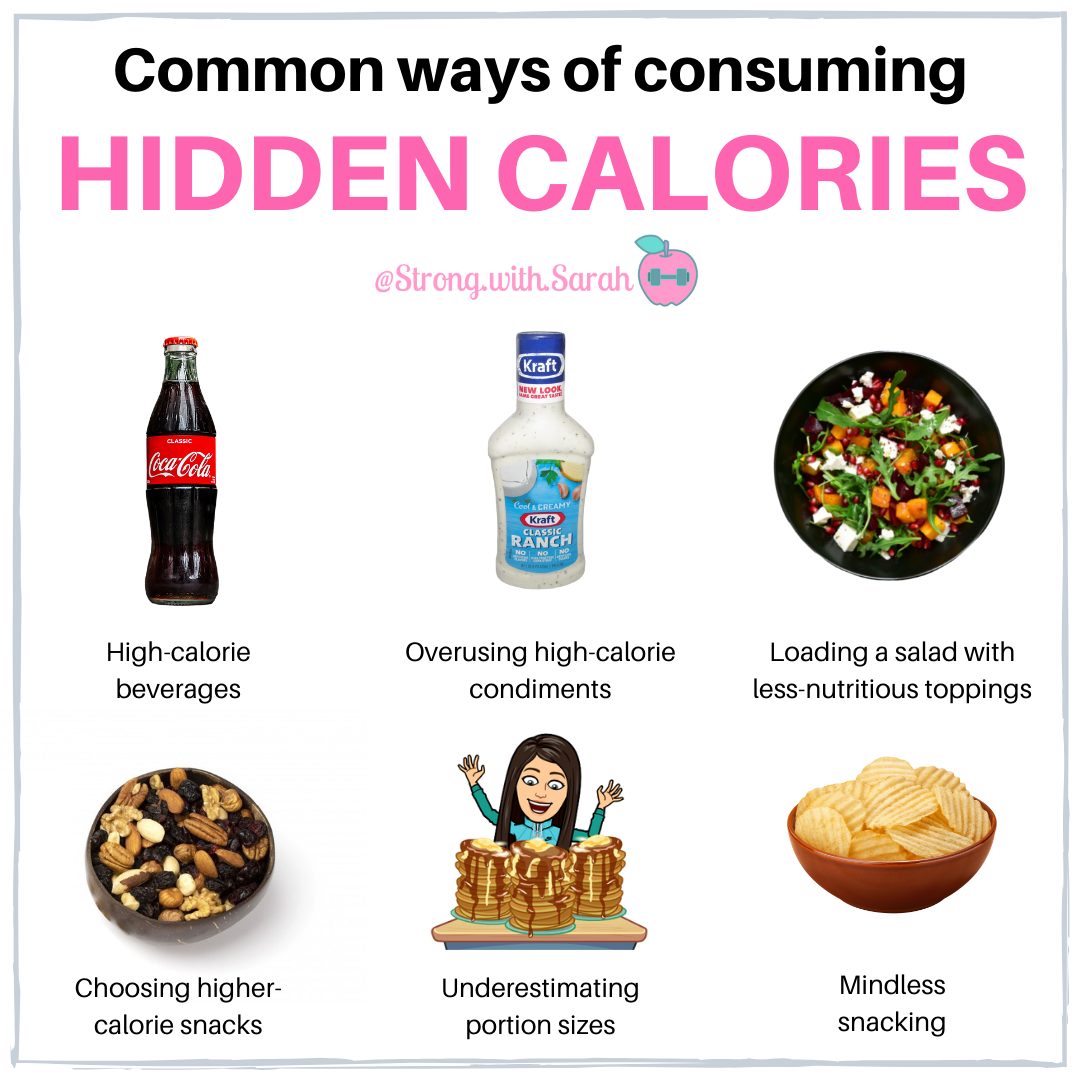
Even healthy foods can contribute to weight gain when portions are excessive. Nuts, avocados, olive oil, and whole grains are nutritious but calorie-dense. A seemingly small increase in these foods can add hundreds of extra calories daily:
- 2 tablespoons extra olive oil = +240 calories
- 1/4 cup extra nuts = +170 calories
- Half an extra avocado = +120 calories
- 1/2 cup extra quinoa = +110 calories
These additions seem minor individually but combined represent over 600 extra calories – enough to prevent weight loss or cause gradual weight gain over time.
Solution: Intuitive portion control without scales
Learn to estimate appropriate portions using simple visual cues and behavioral strategies:
Hand-based portion guide:
- Protein: Palm-sized portion (3-4 oz)
- Vegetables: Two cupped hands (1-2 cups)
- Carbohydrates: One cupped hand (1/2-3/4 cup)
- Fats: Thumb-sized portion (1-2 tablespoons)
Plate composition method: Fill your plate using the “plate method” for balanced, portion-controlled meals:
- 50% non-starchy vegetables
- 25% lean protein
- 25% complex carbohydrates
- Small amount of healthy fats
Environmental controls:
- Use smaller plates and bowls to create portion illusion in reverse
- Serve food in the kitchen rather than family-style at the table
- Store snacks in individual portions rather than large containers
- Fill half your plate with vegetables before adding other foods
The hunger scale technique: Rate your hunger on a scale of 1-10 before eating and aim to stop at a 7 (satisfied but not full). This helps rebuild connection with your body’s natural satiety signals that portion distortion has disrupted.
Eating too fast without chewing properly
Your fork hits the plate repeatedly while you scroll through emails, finishing your meal in under 5 minutes without tasting a single bite. This racing eating pace disrupts crucial digestive processes and prevents your brain from recognizing when you’ve consumed enough food, leading to consistent overeating despite good food choices.
The connection between your stomach and brain requires approximately 20 minutes to communicate fullness effectively. When you eat rapidly, you consume significantly more calories before satiety signals can register, often leaving you uncomfortably stuffed yet somehow unsatisfied.
The physiology of fast eating:
Proper chewing releases digestive enzymes in your saliva that begin breaking down food before it reaches your stomach. Inadequate chewing forces your digestive system to work harder, potentially leading to bloating, gas, and poor nutrient absorption. Additionally, the mechanical act of chewing stimulates the vagus nerve, which helps regulate appetite hormones.
Fast eaters consume an average of 88 more calories per meal compared to slow eaters – seemingly small, but this translates to nearly 10 pounds of weight gain annually. The speed of consumption also affects food satisfaction; meals eaten quickly provide less psychological fulfillment, leading to increased snacking and cravings later.
Hormonal disruption from speed eating:
Ghrelin (hunger hormone) and leptin (satiety hormone) require time to adjust their levels based on food intake. When you eat too quickly:
- Ghrelin doesn’t have time to decrease, leaving you feeling unsatisfied
- Leptin levels don’t rise sufficiently to signal fullness
- Insulin spikes more dramatically from rapid glucose absorption
- Stress hormones remain elevated from rushed eating patterns
Common fast-eating triggers:
- Eating while working or multitasking
- Scheduled time pressure during meals
- Extreme hunger from skipping previous meals
- Emotional eating when stressed or upset
- Competitive eating environments (family meals, work lunches)
- Eating standing up or on-the-go
Solution: Mindful eating techniques for natural pace control
1. The 20-chew rule Count chews for the first few bites of each meal, aiming for 15-20 chews per bite. This seems excessive initially but becomes natural with practice. The extended chewing releases more flavor compounds, making food more satisfying with smaller portions.
2. Utensil placement strategy Put your fork or spoon down between every bite. This simple action forces a natural pause and prevents the automatic “shovel” eating pattern that develops when utensils remain in hand throughout the meal.
3. Create eating rituals Establish pre-meal rituals that shift your nervous system into rest-and-digest mode:
- Take three deep breaths before eating
- Set the table properly, even for solo meals
- Express gratitude for your food
- Turn off all screens and distractions
| Fast Eating Habit | Mindful Alternative | Time Investment | Calorie Reduction |
|---|---|---|---|
| Eating in 5 minutes | Extending to 15-20 minutes | +10-15 minutes | 80-120 calories per meal |
| No chewing awareness | 15-20 chews per bite | No extra time | Better satisfaction, less snacking |
| Multitasking meals | Single-focus eating | Same time, better attention | 15-25% reduction in overeating |
| Standing/rushed eating | Seated, relaxed meals | +5-10 minutes | Improved digestion, portion control |
4. The conversation technique If eating with others, engage in meaningful conversation throughout the meal. This naturally slows eating pace while enhancing the social aspect of dining. For solo meals, practice internal dialogue about flavors, textures, and satisfaction levels.
5. Portion pre-plating with pauses Serve smaller initial portions and implement a 10-minute waiting period before considering seconds. This allows satiety hormones time to communicate fullness and prevents the automatic “clean plate” mentality that overrides hunger cues.
Relying on processed “diet” foods

Supermarket shelves overflow with products labeled “low-fat,” “sugar-free,” “diet,” and “light,” creating the illusion that these processed alternatives support weight loss better than whole foods. However, many diet products contain hidden ingredients that can actually hinder your progress while costing significantly more than natural alternatives.
The processed food industry has mastered the art of removing one macronutrient (like fat or sugar) while adding chemicals, artificial sweeteners, and other additives to maintain palatability. These modifications often result in products that are less satisfying than their whole food counterparts, leading to increased consumption and cravings.
Hidden saboteurs in diet foods:
Low-fat products frequently compensate with added sugars to maintain taste, sometimes containing more calories than full-fat versions. Sugar-free items often include artificial sweeteners that may disrupt gut bacteria and potentially increase sweet cravings over time. Diet foods also tend to be less filling due to reduced protein and fiber content.
The satisfaction deficit:
Processed diet foods rarely provide the sensory satisfaction that whole foods deliver through texture, flavor complexity, and nutritional density. This satisfaction deficit leads to what researchers call “compensatory eating” – consuming additional food to achieve the psychological and physiological satisfaction that the diet product failed to provide.
Many diet products also create a false sense of permission to eat more. People consuming “light” versions of foods often increase their portion sizes by 25-50%, negating any caloric benefits and sometimes consuming more calories than they would with regular versions.
Marketing manipulation tactics:
- “Natural flavors” can include dozens of synthetic compounds
- “Made with real fruit” often means minimal fruit content with added sugars
- “Multigrain” doesn’t guarantee whole grains or fiber
- “No added sugar” may still contain concentrated fruit juices or sugar alcohols
- “Fat-free” products often compensate with refined carbohydrates
Solution: Whole food alternatives that satisfy and nourish
Replace common diet products with satisfying whole food alternatives:
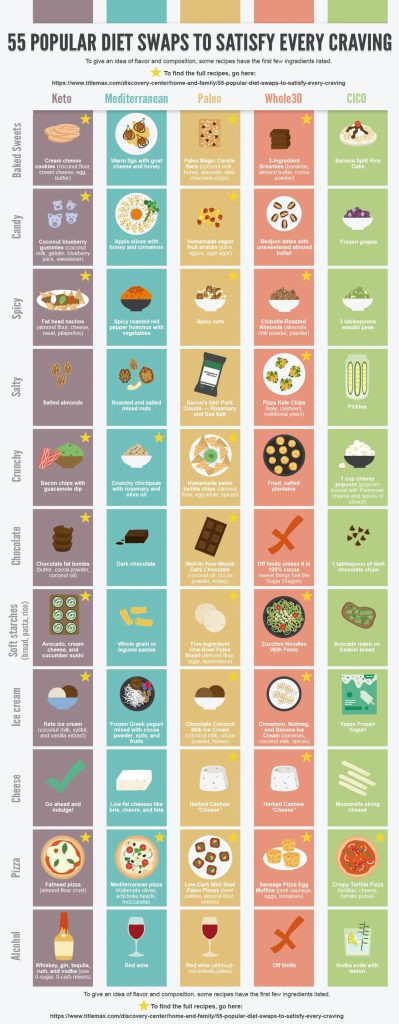
Instead of diet yogurt → Plain Greek yogurt with fresh berries and a drizzle of honey Instead of low-fat salad dressing → Olive oil and vinegar with herbs and spices
Instead of diet frozen meals → Batch-cooked proteins with roasted vegetables Instead of protein bars → Hard-boiled eggs with fruit or nuts with apple slices Instead of diet sodas → Sparkling water with fresh fruit and mint
Smart shopping strategies:
- Shop the perimeter of the grocery store where whole foods are typically located
- Read ingredient lists rather than relying on front-package claims
- Choose foods with fewer than 5 recognizable ingredients
- Buy plain versions and add your own flavors (plain oatmeal vs. flavored packets)
- Prepare larger batches of whole foods to match convenience factor of processed options
The 5-ingredient rule: When buying packaged foods, limit choices to products containing 5 or fewer ingredients that you can pronounce and recognize as actual food. This simple rule eliminates most highly processed diet products while allowing for minimally processed conveniences like canned beans or frozen vegetables.
Focus on foods that provide sustained energy and satisfaction rather than products promising quick fixes. Whole foods naturally regulate appetite through their fiber, protein, and water content, making portion control easier and more intuitive than with processed alternatives.
Not getting enough quality sleep

Sleep deprivation triggers a hormonal cascade that makes weight loss nearly impossible, regardless of how perfectly you eat or exercise. When you consistently get less than 7 hours of quality sleep, your body produces more ghrelin (hunger hormone) and less leptin (satiety hormone), creating intense cravings for high-calorie foods while simultaneously reducing your ability to feel satisfied after eating.
Research shows that people who sleep less than 6 hours per night are 30% more likely to become obese compared to those who sleep 7-9 hours. Poor sleep quality also increases cortisol production, which promotes fat storage particularly around your midsection while breaking down muscle tissue that’s crucial for maintaining a healthy metabolism.
The metabolic disruption of sleep loss:
During deep sleep, your body releases growth hormone that helps repair tissues and maintain muscle mass. Without adequate deep sleep phases, your metabolism slows significantly, and your body becomes less efficient at processing carbohydrates. This leads to higher blood sugar levels and increased insulin resistance, making fat storage more likely.
Sleep deprivation also affects your prefrontal cortex – the brain region responsible for decision-making and impulse control. When sleep-deprived, you’re more likely to make poor food choices, eat larger portions, and give in to cravings for sugary, high-fat foods that provide quick energy to combat fatigue.
Common sleep disruptors affecting weight:
- Screen exposure within 2 hours of bedtime
- Caffeine consumption after 2 PM
- Large meals or alcohol close to bedtime
- Irregular sleep schedules, even on weekends
- Bedroom temperatures above 68°F (20°C)
- Stress and anxiety from daily pressures
The relationship between sleep and weight is bidirectional – poor sleep promotes weight gain, while excess weight can worsen sleep quality through issues like sleep apnea and increased inflammation. Breaking this cycle requires addressing both sleep hygiene and weight management simultaneously.
Solution: Sleep optimization for weight loss
Create a sleep-friendly environment:
- Keep your bedroom between 65-68°F (18-20°C)
- Use blackout curtains or an eye mask to eliminate light
- Remove electronic devices or use blue light filters after sunset
- Invest in a comfortable mattress and pillows that support proper alignment
Establish a consistent pre-sleep routine: Begin winding down 2 hours before your target bedtime:
- 2 hours before: Stop eating and finish any vigorous exercise
- 1 hour before: Dim lights and begin relaxing activities (reading, gentle stretching)
- 30 minutes before: Complete all screens and electronics
- Bedtime: Practice deep breathing or meditation
| Sleep Duration | Ghrelin Increase | Leptin Decrease | Weight Gain Risk |
|---|---|---|---|
| 4-5 hours | +28% | -18% | 73% higher |
| 5-6 hours | +15% | -15% | 30% higher |
| 6-7 hours | +8% | -8% | 23% higher |
| 7-9 hours | Normal levels | Normal levels | Baseline |
Timing strategies for better sleep:
- Stop caffeine intake after 2 PM to prevent sleep interference
- Finish dinner at least 3 hours before bedtime to allow proper digestion
- If evening hunger strikes, choose light protein snacks like Greek yogurt
- Limit fluid intake 2 hours before bed to minimize sleep disruptions
Natural sleep enhancement:
- Morning sunlight exposure helps regulate circadian rhythms
- Regular exercise improves sleep quality but avoid vigorous activity within 4 hours of bedtime
- Magnesium supplements (200-400mg) can promote relaxation
- Chamomile tea or valerian root may help with sleep onset
Overestimating calories burned during exercise
Fitness trackers and gym equipment often inflate calorie burn estimates by 15-25%, leading many people to “eat back” more calories than they actually burned during exercise. This overestimation, combined with post-workout hunger and the psychological reward of “earning” food through exercise, frequently results in consuming more calories than were expended.
The reality of calorie burn is often disappointing compared to expectations. A 30-minute moderate-intensity workout typically burns 150-300 calories for most people – equivalent to a small snack or single cookie. Yet many exercisers reward themselves with 400-500 calorie post-workout meals, completely negating their caloric deficit.
Factors affecting actual calorie burn:
- Body weight: Heavier individuals burn more calories during the same activity
- Fitness level: Well-trained bodies become more efficient and burn fewer calories
- Exercise intensity: Heart rate and perceived exertion affect calorie expenditure
- Muscle mass: More muscle tissue increases both resting and active metabolic rate
- Age and gender: Younger males typically have higher calorie burn rates
The compensation effect:
Your body naturally compensates for increased exercise by reducing non-exercise activity throughout the day. This phenomenon, called “activity thermogenesis compensation,” means you might burn 300 calories during a workout but then burn 100 fewer calories through reduced fidgeting, taking elevators instead of stairs, or feeling more sedentary the rest of the day.
Many people also experience increased appetite after exercise, particularly following high-intensity or long-duration workouts. This biological response evolved to help restore energy reserves but can easily lead to overconsumption in our calorie-abundant environment.
Realistic calorie burn expectations:
Moderate activities (30 minutes for 150lb person):
- Walking 3.5 mph: 140 calories
- Cycling leisurely: 180 calories
- Swimming laps: 220 calories
- Yoga or Pilates: 120 calories
Vigorous activities (30 minutes for 150lb person):
- Running 6 mph: 300 calories
- High-intensity interval training: 250 calories
- Spinning class: 280 calories
- Circuit training: 240 calories
Solution: Exercise for health, diet for weight loss
Shift your exercise mindset: View exercise primarily as a tool for improving health, mood, and fitness rather than earning food calories. This mental shift prevents the reward-based eating that often follows workouts and helps maintain a sustainable caloric deficit.
Post-workout nutrition strategy:
- Wait 30-60 minutes after exercise before eating unless genuinely hungry
- Choose protein-rich snacks to support muscle recovery without excess calories
- Hydrate first – thirst is often mistaken for hunger after sweating
- Plan post-workout meals rather than making impulsive food choices
Focus on non-scale victories: Track improvements in strength, endurance, flexibility, and energy levels rather than relying solely on calorie burns or weight changes. These metrics provide more accurate feedback about your fitness progress and help maintain motivation during weight loss plateaus.
The 80/20 principle applied: Remember that weight loss is approximately 80% diet and 20% exercise. Use exercise to enhance your overall health and accelerate fat loss, but don’t rely on it as your primary weight loss strategy. A consistent caloric deficit through mindful eating remains the most effective approach for sustainable weight management.
Chronic stress eating patterns

Stress triggers a complex hormonal response that directly sabotages weight loss efforts by increasing appetite, promoting fat storage, and disrupting sleep patterns. When cortisol levels remain elevated due to chronic stress, your body interprets this as a survival threat and responds by storing energy as fat, particularly around your midsection where it’s easily accessible for quick energy.
The stress-eating cycle becomes self-perpetuating: stress increases cravings for high-calorie comfort foods, eating these foods provides temporary relief but leads to guilt and weight gain, which creates more stress and continues the destructive pattern. Breaking this cycle requires addressing both the stress response and the eating behaviors it triggers.
The physiology of stress-induced weight gain:
Elevated cortisol levels increase production of neuropeptide Y, a brain chemical that stimulates appetite specifically for carbohydrate-rich foods. This biological response evolved to help our ancestors store energy during threatening situations, but in modern life, chronic stressors like work pressure, financial concerns, and relationship issues keep this system constantly activated.
Stress also disrupts your body’s natural hunger and satiety signals. When cortisol is high, leptin (the hormone that signals fullness) becomes less effective, while ghrelin (hunger hormone) increases. This combination makes you feel hungrier than usual while simultaneously reducing your ability to recognize when you’ve eaten enough.
Common stress eating triggers:
- Work deadlines and pressure
- Financial worries and uncertainty
- Relationship conflicts or loneliness
- Major life changes or transitions
- Perfectionism and self-criticism
- Boredom or lack of stimulation
- Social situations and peer pressure
Emotional vs. physical hunger identification:
Learning to distinguish between stress-driven emotional hunger and genuine physical hunger is crucial for breaking stress eating patterns:
Physical hunger: Develops gradually, can be satisfied with various foods, stops when full, no guilt afterward Emotional hunger: Comes on suddenly, craves specific comfort foods, persists despite fullness, often followed by guilt
Solution: Stress management techniques for weight control
Immediate stress response strategies: When you feel the urge to stress eat, try the STOP technique:
- Stop what you’re doing
- Take three deep breaths
- Observe your current emotional state
- Proceed with intention rather than reaction
Alternative stress relief activities: Replace food-based comfort with activities that address stress directly:
- 5-minute walk outside for fresh air and movement
- Call a friend or family member for social connection
- Practice progressive muscle relaxation
- Listen to calming music or nature sounds
- Engage in a creative activity like drawing or writing
| Stress Level | Common Food Cravings | Healthy Alternative | Time Required |
|---|---|---|---|
| Mild stress | Sweet snacks, chips | Herbal tea, fruit | 5 minutes |
| Moderate stress | Ice cream, chocolate | Hot bath, gentle yoga | 15-20 minutes |
| High stress | Fast food, large portions | Walk, call friend | 10-30 minutes |
| Overwhelming stress | Binge eating episodes | Professional support | Ongoing |
Long-term stress management:
- Regular exercise: Even 10 minutes daily reduces cortisol levels
- Meditation or mindfulness: 5-10 minutes daily practice builds stress resilience
- Adequate sleep: 7-9 hours nightly helps regulate stress hormones
- Social support: Regular connection with friends and family
- Time management: Breaking large tasks into smaller, manageable steps
Creating a stress-eating emergency kit: Prepare a list of non-food activities you can do when stress eating urges strike:
- Text three supportive friends or family members
- Take a shower or bath
- Do 10 jumping jacks or push-ups
- Practice deep breathing for 2 minutes
- Write in a journal about your feelings
Inconsistent meal timing habits

Your body operates on internal circadian rhythms that expect food at regular intervals throughout the day. When meal timing becomes erratic – eating breakfast at 6 AM one day and 10 AM the next, or having dinner at 5 PM sometimes and 9 PM other times – it disrupts these natural rhythms and can slow your metabolism while increasing fat storage.
Irregular eating patterns confuse your body’s hunger and satiety hormones, leading to unpredictable appetite fluctuations and energy crashes. Your metabolism works most efficiently when it can anticipate regular fuel intake, allowing for optimal digestion and nutrient utilization.
The science of meal timing:
Research shows that eating the majority of your calories earlier in the day supports better weight management than consuming large meals later. Your body’s insulin sensitivity is highest in the morning and gradually decreases throughout the day, meaning carbohydrates are processed more efficiently earlier rather than later.
Late-night eating disrupts your natural fasting period, which is crucial for cellular repair processes and fat burning. When you eat close to bedtime, your body focuses on digestion rather than the restorative processes that normally occur during sleep, potentially affecting both sleep quality and metabolic function.
Common meal timing mistakes:
- Skipping breakfast and eating large dinners
- Eating at different times each day based on schedule
- Late-night snacking or meals within 3 hours of bedtime
- Going more than 4-5 hours between meals during the day
- Weekend eating schedules that differ drastically from weekdays
The intermittent fasting confusion:
While intermittent fasting can be effective for some people, inconsistent timing is different from planned fasting windows. Random meal skipping followed by large meals creates metabolic confusion rather than the structured approach that makes intermittent fasting effective.
Solution: Establishing consistent meal rhythms
Create a personal meal schedule: Design a realistic eating schedule that works with your lifestyle and stick to it within 1-2 hours daily:
Sample schedule for early risers:
- 7:00 AM – Breakfast
- 10:00 AM – Morning snack (if needed)
- 1:00 PM – Lunch
- 4:00 PM – Afternoon snack
- 7:00 PM – Dinner
Sample schedule for later schedules:
- 9:00 AM – Breakfast
- 12:00 PM – Lunch
- 3:00 PM – Afternoon snack
- 7:00 PM – Dinner
- 9:00 PM – Light evening snack (if needed)
Meal prep strategies for consistency:
- Prepare breakfast items the night before
- Pack snacks and lunch for work days
- Batch cook proteins and vegetables on weekends
- Set phone reminders for meal times during transition period
- Keep backup healthy options available for schedule disruptions
Weekend vs. weekday balance: Maintain similar meal timing on weekends to avoid disrupting your established rhythm. If social events require later meals, adjust earlier meals slightly rather than skipping them entirely.
Travel and schedule changes: When traveling or facing schedule changes, maintain meal frequency even if timing shifts. Focus on eating every 3-4 hours rather than adhering to specific clock times, and return to your regular schedule as soon as possible.
Listening to hunger cues within structure: While consistency is important, also pay attention to genuine hunger and fullness signals. The goal is creating a framework that supports stable energy and appetite while remaining flexible enough to accommodate your body’s natural variations.
Conclusion
Breaking the habits that sabotage your weight loss isn’t about perfection—it’s about awareness, strategy, and persistence. The 11 habits we’ve explored represent the most common hidden obstacles that prevent people from achieving their health goals, but now you have the tools to overcome each one.
Remember that lasting change happens gradually. Choose one habit to focus on first, implement the replacement strategies we’ve discussed, and give yourself time to adapt. Your brain needs approximately 66 days to form a new habit, so patience with yourself is crucial.
The journey to sustainable weight loss isn’t about quick fixes or extreme measures. It’s about creating a lifestyle that naturally supports your health goals while still allowing you to enjoy life. By addressing these sabotaging habits systematically and building supportive new patterns, you’re not just losing weight—you’re gaining a healthier, more energetic, and more confident version of yourself.
Start today with one small change. Your future self will thank you for taking this important step toward lasting transformation.

